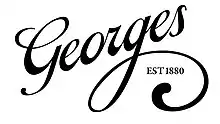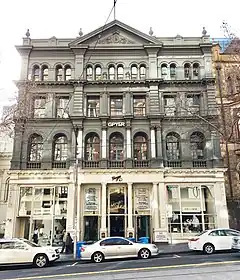Georges (store)
Georges was a department store in Melbourne, Victoria, Australia, established in 1880 and closed in 1995, and was well known for its last 50 years as the city’s premier women's wear department store.[1]
 | |
| Type | Department Store |
|---|---|
| Industry | Retail |
| Founded | 1880as George's and George's Federal Emporium |
| Defunct | 1995 |
| Fate | Acquired by David Jones |
| Headquarters | Melbourne, Victoria, Australia |
Key people | William George and Alfred George (founders) |
| Products |
|
| Website | http://www.georgesoncollins.com.au/ |
Georges began in 1880 when brothers William Henry and Alfred Harley George (who were in their late 20s) took over Robinson’s drapers at 37 Collins Street East as George & George’s. Finding success in a booming economy, in 1883 they moved a few doors down to a large four storey building at 11-17 Collins Street East (now 280 Collins Street), which had been built in 1877 as Briscoe's warehouse[2][3]), and rebranded as George & George’s Federal Emporium. In 1888, when financier Benjamin Fink bought the building, planning to replace the it with an arcade, they bought the business of the Equitable Co-operative Store, located a block away, up a hill, and away from the retail heart of the city.[4] It was a grand classical revival style building at what is now 162-168 Collins Street, and was built in 1884, designed by architects John Grainger and Charles D'Ebro.[5] For over a year they ran the business in the two sites, until in September 1889 a disastrous fire destroyed their 280 Collins premises (which was then replaced by the first stage of the Block Arcade).[6] Despite being under insured, they kept the business going at the new location. soon doing well enough that in 1891 the building was refurbished and extended through to Little Collins Street, designed by D'Ebro alone.[7][8]
By the early 1900s the store specialised in women's wear and accessories, and in 1908 (after financial restructuring) undertook a major renovation, inserting a full height atrium in the centre, and building extensive ‘walk-through’ show windows on Collins Street, to provide for window shoppers in a period when store hours were finally curtailed through labour laws.[5]

Another renovation in 1938 created a spacious uncluttered store interior, creating a more upmarket environment. In the late 1940s the store began to focus on catering to a more well heeled clientele, though anyone was welcome, and innovated with extra features such as stylish, minimalist window displays, regular fashion parades showing the latest styles, and later added an art gallery.
Georges developed a reputation for superior quality equal to that enjoyed by Harrods or Fortnum & Mason of London, and Bergdorf Goodman of New York.[4] The store's motto was Quod facimus, Valde facimus (What we do, We do well), as the firm had a philosophy of providing exclusive goods and meticulous service. The stores' staff handbook instructed employees to avoid high pressure sales techniques. Author and customer Annette Cooper states that Georges: "wanted to foster loyalty, and if they made you feel good about coming into the store you would come back."[9]
The firm was taken over by retail holding company Cox Brothers in November 1960 through the purchase of all the ordinary paid up capital in Georges Holding Limited.[10] Cox Brothers began to incur loses in 1962/63[10] and went into receivership in 1966. Georges was listed (again) as a new company on the Melbourne Stock Exchange as Georges Australia Limited.[11]
In January, 1970, Georges launched a successful takeover bid of Ball & Welch in a deal valued at $A1.48 million dollars.[12][13] The directors of Georges believed that Ball & Welch stores would give Georges a foothold in the suburbs.[12] Instead, Georges closed all of the Ball & Welch stores by 1976 selling the flagship Flinders Street store in May, 1976.[14]
David Jones then took over Georges in 1981. During the 1980s, two smaller Georges' branches were briefly opened: The Jam Factory on Chapel Street, South Yarra, and the other on Burke Road, Camberwell.
The store closed on 5th October 1995,[15][8] and in the 2020s George's still remains a well remembered part of Melbourne's history by the generations that enjoyed shopping there.
Published books
The store had such cache that there have been four books published with the store as a central theme. In 1979 journalist Keith Dunstan published The Store on the HIll.[4] Since it closed there have been three more, two by former head of visual merchandising Laurie Carew,[16] with former model Diane Masters, Behind the Glass in 2003,[17] and Still Here in 2006. In 2014, Remembering Georges : stories from Melbourne's most elegant store,[18] a compendium of interviews with former employees and photographs by Annette Cooper was published.
A family anecdote
as well as by former employees. The Powne family holds a personal connection to this day. William Powne was a migrant from Cornwall, who initially had a drapery business in Ballarat named Powne and Cray, and later worked for the George brothers when the store was still the Federal Emporium. In 1886, Powne gave notice that he would be leaving to start a drapery business in Clarendon Street, Melbourne. As a mark of esteem for Powne, the George brothers gave Powne a purse of sovereigns 'as a token of their respect and goodwill'. This kind act was perhaps so unusual, and the company so prominent, that it was reported in The Age on 14 September 1886.[19]
These sovereigns have been passed down through William Powne's children and beyond and in 2020 still continues, with the success story of George and George being front and centre.
References
- eMelbourne Encyclopedia, Blog, 'Georges'
- "A New Enterprise". The Age. 11 September 1883. p. 6. Retrieved 23 June 2020 – via Trove.
- "The New Warehouses of Messrs. Briscoe and Co., Collins—Street East". The Australasian Sketcher with Pen and Pencil. 1 September 1877. p. 93. Retrieved 23 June 2020 – via Trove.
- "The store on the hill / [by] Keith Dunstan - Catalogue | National Library of Australia". catalogue.nla.gov.au. Retrieved 18 October 2023.
- "Former George's Store". Victorian Heritage Database. Retrieved 8 February 2023.
- "Messrs. George and George's Premises". The Argus. No. 13,516. Melbourne. 17 October 1889. p. 8. Retrieved 15 March 2019 – via Trove.
- "Opening of George and Georges New Buildings". The Argus. 22 September 1891. p. 10. Retrieved 21 June 2018.
- Cooper, Annette. Remembering Georges: stories from Melbourne's most elegant store. ISBN 978-1-922129-46-8. OCLC 880138550.
- "Georges on Collins department store remembered for elegance". ABC News. 10 November 2014. Retrieved 3 November 2022.
- Consultancy, Archive Research. "Cox Brothers (Australia) Limited - Corporate entry - Guide to Australian Business Records". www.gabr.net.au. Retrieved 3 November 2022.
- Consultancy, Archive Research. "Cox Brothers (Australia) Limited - Corporate entry - Guide to Australian Business Records". www.gabr.net.au. Retrieved 3 November 2022.
- "Georges offers $1½m for Ball and Welch". Canberra Times. 23 January 1970. Retrieved 3 November 2022.
- "SHARP RISE IN GEORGES SHARE PRICE". Canberra Times. 11 November 1971. Retrieved 3 November 2022.
- "Goodyear loses $4.5m in 1975". Canberra Times. 1 June 1976. Retrieved 3 November 2022.
- Dunstan, Keith, The store on the hill, Macmillan Publishers, Melbourne, 1979
- Harper, Annie (2 May 2014). "Artist showed European style through his windows". The Sydney Morning Herald. Retrieved 18 October 2023.
- "Behind glass / Laurie Carew, with Diane Masters - Catalogue | National Library of Australia". catalogue.nla.gov.au. Retrieved 18 October 2023.
- "Remembering Georges : stories from Melbourne's most elegant store / Annette Cooper - Catalogue | National Library of Australia". catalogue.nla.gov.au. Retrieved 18 October 2023.
- "Alleged Bigamy". The Age. 14 September 1886. p. 6. Retrieved 10 April 2021.